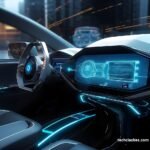The auto business is going through Automotive Technologies, driven by state-of-the-art innovations that are reshaping how we ponder vehicles. From brilliant vehicles to man-made brainpower, supportability, and networks, the fate of rides is being changed. We should plunge into the best five auto innovations that are driving us into another period of transportation.
In reality, as we know it where innovation is progressing at an extraordinary speed, the auto business is no exception. The joining of creative innovations isn’t just upgrading the driving experience yet in addition preparing for a more secure and more feasible future. This article investigates the main five car advances that are at the very front of this unrest.
Smart Cars: A Glimpse into the Future
- The evolution of smart cars.
- Features and capabilities of modern smart vehicles
(1) The evolution of smart cars
The development of brilliant vehicles has been completely exceptional, changing how we see and collaborate with cars. What once appeared as a modern idea is presently a substantial reality, with savvy vehicles assuming an essential part in molding the eventual fate of transportation.
(2) Features and capabilities of modern smart vehicles
Present-day splendid vehicles boast a lot of features and limits that rename the driving experience. As advancement continues to impel, Automotive Technologies these vehicles consolidate best-in-class advancements to further develop prosperity, solace, and as a rule for the two drivers and explorers.
Free Driving Development
One of the hero features of present-day splendid vehicles is autonomous driving advancement. Furnished with sensors, cameras, and undeniable level estimations, Automotive Technologies these vehicles can investigate, essentially choose, and even park without direct human mediation. The development helped to make a beeline for totally free limits tends to a gigantic leap in auto improvement.
Undeniable level Driver Help Structures (ADAS)
Current splendid vehicles are equipped with various ADAS, including features like adaptable excursion control, waykeeping help, and customized emergency dialing back. These structures work pair to improve overall prosperity by giving persistent alerts and interventions to thwart crashes and assuage likely risks.
Accessibility and Infotainment
The network is an indication of keen vehicles, offering a steady blend of mobile phones and various contraptions. Infotainment structures outfit drivers and voyagers with permission to an extent of organizations, including courses, Automotive Technologies music streaming, and hand-calling. Voice affirmation development further develops the client experience by considering regular and interference-free correspondence.
Vehicle-to-Everything (V2X) Correspondence
Current keen vehicles are fundamental for an interconnected organic framework known as V2X correspondence. This advancement engages vehicles to talk with each other, Automotive Technologies too moreover with traffic signals, systems, and walkers. This constant exchange of information updates the traffic stream, lessens blockage, and further grows taking everything into account security.
Electric and Cross variety of Driving force
Legitimacy is an essential fixation in present-day sagacious vehicles, with many merging electric or cross-variety force systems. Electric vehicles (EVs) use battery power, Automotive Technologies lessening surges and reliance on ordinary non-environmentally friendly power sources. Crossbreed models join standard start engines with electric parts for extended viability and diminished environmental impact.
Farsighted Help
Insightful vehicles impact data examination and simulated intelligence to engage judicious upkeep. Sensors screen the vehicle’s prosperity and execution, making drivers and organization centers mindful of expected issues before they arise. This proactive procedure limits edge time, further creates trustworthiness, and in the long run, expands the future of the vehicle.
Biometric ID
Overhauling security and personalization, a couple of insightful vehicles incorporate biometric ID features. These systems can see individual drivers considering fingerprints, facial affirmations, or voice plans, taking into account changed settings and access controls.
Expanded Reality (AR) Grandstands
Extended unscripted TV dramas in sharp vehicles give continuous information, for instance, Automotive Technologies course direction and prosperity alerts, clearly onto the windshield or a dedicated up-front control center. This advancement advances situational care for drivers without anticipating that they should move their concentrate away from the road.
Over-the-Air (OTA) Updates
Splendid vehicles embrace an all the more remarkable method for managing programming invigorates through OTA limits. This licenses producers to remotely revive and redesign vehicle programming, adding new components, further creating execution, and addressing security shortcomings without requiring a visit to the display area.
Eco-Obliging Materials and Plan
Despite down-to-earth impulse structures, present-day splendid vehicles now and again merge eco-obliging materials in their arrangement. From reused inside surfaces to competently got parts, creators center around earth-conscious choices in both the collecting framework and the vehicle’s everyday organic impression.
AI Integration in Automobiles
- Role of Artificial Intelligence in Automotive Technology.
- Examples of AI applications in cars.
(1) Role of Artificial Intelligence in Automotive Technology
Man-made consciousness (computer-based intelligence) has arisen as a groundbreaking power in the auto business, upsetting how vehicles are planned, worked, and experienced. Its mix has prompted historic headways, improving security, proficiency, and general driving abilities. Here is an exhaustive investigation of the diverse job that artificial intelligence plays in forming the fate of auto innovation.
Independent Driving:
Man-made intelligence fills in as the foundation for accomplishing independent driving capacities. Through many-sided AI calculations, vehicles can decipher and answer their environmental elements continuously. This empowers highlights like self-route, hindrance discovery, and versatile direction, preparing for another period of driverless transportation.
High-level Driver Help Frameworks (ADAS):
Consolidating computer-based intelligence, High-level Driver Help Frameworks (ADAS) altogether hoist vehicle security. Artificial intelligence calculations process information from sensors, cameras, and radars to give ongoing experiences. Highlights like path-keeping help, versatile journey control, and impact evasion frameworks are engaged by man-made intelligence, improving driver mindfulness and moderating expected gambles.
Prescient Upkeep:
Computer-based intelligence-driven prescient support models have re-imagined vehicle upkeep. By dissecting information from different parts, computer-based intelligence predicts possible issues before they heighten, empowering proactive support. This lessens upkeep costs as well as improves vehicle unwavering quality and limits startling breakdowns.
Normal Language Handling (NLP) and Human-Machine Communication:
Computer-based intelligence’s Regular Language Handling (NLP) abilities upgrade correspondence among drivers and vehicles. Voice acknowledgment frameworks fueled by computer-based intelligence empower without hands command over different capabilities, making a more secure and more natural in-vehicle experience. Drivers can flawlessly interface with their vehicles utilizing voice orders, cultivating a more associated driving climate.
Customized In-Vehicle Experience:
Simulated intelligence fits the in-vehicle experience to individual inclinations. Whether changing environment settings, seat positions, or diversion choices, computer-based intelligence-driven frameworks establish a customized driving climate. This improves solace as well as lays out a more pleasant and client-driven venture.
Traffic Expectation and Route:
Artificial intelligence calculations examine tremendous datasets to foresee traffic designs and improve route courses. This guides in decreasing travel time as well as adds to eco-friendliness and limits natural effects. Simulated intelligence-driven route frameworks adjust progressively to constant traffic conditions, offering drivers the most proficient courses.
Crash Evasion Frameworks:
Computer-based intelligence improves crash aversion frameworks by handling sensor information to recognize likely dangers and make quick restorative moves. These frameworks can independently apply slows down or change directing to forestall mishaps, giving an extra layer of security for the two drivers and people on foot.
Improved Picture and Article Acknowledgment:
Computer-based intelligence’s picture and item acknowledgment capacities assume a pivotal part in recognizing and answering components out and about. From walkers to cyclists and different vehicles, simulated intelligence guarantees an uplifted mindfulness, adding to general street well-being.
Network safety:
As vehicles become more associated, computer-based intelligence assumes an imperative part in online protection. Simulated intelligence calculations screen network exercises, recognizing and answering potential digital dangers. This shields the honesty of vehicle programming frameworks, guaranteeing a protected driving encounter.
Mental Processing for Navigation:
Computer-based intelligence’s mental figuring abilities engage vehicles to settle on complex choices continuously. Whether exploring testing territories or answering unanticipated conditions, simulated intelligence empowers vehicles to adjust and go with choices likened to human mental cycles.

(2) Examples of AI applications in cars
Simulated intelligence applications in vehicles have changed the car business, presenting state-of-the-art advances that improve security, effectiveness, and generally speaking driving experience. Here are remarkable instances of how Man-made brainpower is utilized in present-day vehicles:
Independent Driving:
Application: Self-driving vehicles influence man-made intelligence for constant independent direction, utilizing sensors and cameras to explore, distinguish deterrents, and answer changing street conditions. Organizations like Tesla, Waymo, and others have executed simulated intelligence-driven independent elements.
High-level Driver Help Frameworks (ADAS):
Application: ADAS uses man-made intelligence to improve driver well-being. Highlights like versatile journey control, path-keeping help, and programmed crisis slowing down depend on simulated intelligence calculations to handle sensor information, giving continuous alarms and intercessions.
Regular Language Handling (NLP) for Voice Orders:
Application: simulated intelligence-driven NLP permits drivers to communicate with their vehicles utilizing voice orders. Remote helpers like Siri in Apple CarPlay and Google Aide in Android Auto comprehend and answer normal language, giving sans hands command over different capabilities.
Prescient Upkeep:
Application: artificial intelligence examines information from different vehicle parts to foresee possible issues before they happen. This empowers proactive upkeep, lessening margin time and improving the general unwavering quality of the vehicle.
Keen Infotainment Frameworks:
Application: computer-based intelligence powers canny infotainment frameworks that learn client inclinations over the long run. Frameworks like BMW’s iDrive and Mercedes-Benz MBUX use artificial intelligence to suggest music, change environment settings, and give customized content in light of the driver’s propensities.
Traffic Expectation and Route:
Application: simulated intelligence calculations break down traffic designs continuously, improving route courses to keep away from blockage. Route frameworks like Google Guides use artificial intelligence to give dynamic, effective, and exact course ideas to drivers.
Impact Aversion Frameworks:
Application: simulated intelligence upgrades crash evasion frameworks by handling information from sensors to recognize possible dangers. These frameworks can independently apply slows down or change guiding to forestall crashes, adding to in general street security.
Facial Acknowledgment for Driver Checking:
Application: artificial intelligence-driven facial acknowledgment frameworks screen drivers for indications of weakness or interruption. Mercedes-Benz’s Consideration Help, for example, utilizes artificial intelligence to examine driver conduct and give cautions assuming indications of sluggishness are recognized.
Versatile Lighting Frameworks:
Application: simulated intelligence-controlled versatile lighting frameworks change headlights given driving circumstances, speed, and the presence of different vehicles. This upgrades permeability without causing glare for approaching drivers, working on by and large well-being.
Motion Control:
Application: A few vehicles integrate man-made intelligence-driven signal control frameworks, permitting drivers to collaborate with infotainment highlights through hand motions. BMW’s Signal Control is a model that empowers clients to control sound volume, answer calls, or explore menus with straightforward hand developments.
Sustainable Solutions
- Eco-friendly technologies in the automotive sector.
(1) Eco-friendly technologies in the automotive sector
Eco-accommodating innovations in the auto area assume a critical part in relieving natural effects and encouraging practical transportation arrangements. As the business keeps on advancing, various advancements are adding to greener and more naturally cognizant practices. Here are key eco-accommodating advancements in the car area:
Electric Vehicles (EVs):
Innovation Outline: EVs run on power put away in batteries, dispensing with the requirement for conventional gas-powered motors. They produce zero tailpipe outflows, fundamentally decreasing air contamination.
Influence: Lessens reliance on petroleum derivatives, diminishes ozone-depleting substance outflows and advances cleaner air quality in metropolitan regions.
Cross-breed Vehicles:
Innovation Outline: Cross-breed vehicles consolidate conventional gas-powered motors with electric impetus. They use electric power at lower paces and change to gas at higher velocities or when extra power is required.
Influence: Further develops eco-friendliness, lessens outflows, and gives a momentary arrangement toward completely electric vehicles.
Module Half and Half Electric Vehicles (PHEVs):
Innovation Outline: PHEVs have a double powertrain – electric and gas. They can be charged through a power plug and utilize a fuel motor when required.
Influence: Offers adaptability with electric-just driving for brief excursions and the lengthy scope of a gas motor for longer excursions, lessening generally speaking fuel utilization.
Hydrogen Energy Unit Vehicles:
Innovation Outline: Hydrogen energy unit vehicles produce power by joining hydrogen and oxygen, emanating just water fume as a side-effect.
Influence: Produces no discharges at the tailpipe, gives a more drawn-out driving reach contrasted with a few electric vehicles, and supports a practical hydrogen framework.
Regenerative Slowing mechanisms:
Innovation Outline: Regenerative slowing down catches and stores energy normally lost as intensity during slowing down. This energy is then used to re-energize the vehicle’s battery.
Influence: Further develops generally speaking energy productivity, improves battery duration, and adds to fuel reserve funds in half-breed and electric vehicles.
Conclusion
With everything considered, the auto business is going through a gigantic change driven by innovative improvements that accentuate natural reasonableness, security, and feasibility. The joining of eco-obliging turns of events, for example, electric vehicles, hydrogen power contraptions, and regenerative moving back instruments, mirrors a confirmation of reducing the typical effect of transportation.
As electric vehicles gain conspicuousness, they add to cleaner air quality as well as plan for a future with diminished dependence on standard non-supportable power sources. Cream improvements, remembering plug-for cross assortments and hydrogen energy units, give versatile blueprints that take uncommon thought of various driving requirements, offering a stage among common and electric vehicles.
Past power frameworks, kinds of progress in lightweight materials, and green get-together practices show a broad system toward sensibility. The vehicle locale is embracing materials like aluminum and carbon fiber to decrease vehicle weight, as such improving eco-generosity, and chopping down overflows. Meanwhile, reasonable social affair rehearses mean to confine waste and advance asset ability all through the creation correspondence.
FAQs
Q: Are electric vehicles (EVs) more harmless to the ecosystem than conventional gas-controlled vehicles?
Indeed, electric vehicles are for the most part more harmless to the ecosystem as they produce zero tailpipe outflows. Notwithstanding, their general effect relies upon variables, for example, the wellspring of power utilized for charging and the assembling processes.
Q: How do regenerative stopping mechanisms work, and how would they add to eco-accommodating driving?
Regenerative stopping mechanisms catch and store energy while slowing down, changing it into power. This further develops energy productivity as well as broadens the scope of electric and half-and-half vehicles while lessening wear on conventional stopping mechanisms.
Q: What is the distinction among mixture and module crossover vehicles?
Mixture vehicles utilize a mix of a gas-powered motor and an electric engine, with the electric engine helping during low-speed driving. Module half-and-half vehicles, then again, can be charged remotely and have a bigger electric-just reach, diminishing dependence on the gas motor for brief excursions.
Q: How might sun-oriented fueled vehicles add to practical transportation?
Sun-oriented controlled vehicles utilize photovoltaic cells to change daylight into power, enhancing the vehicle’s power source. While the innovation is as yet advancing, it can diminish reliance on outer charging foundations and lower the general carbon impression.
Q: What are a few difficulties in the far and wide reception of electric vehicles?
Difficulties incorporate a restricted charging foundation, high starting expenses, and worries about range uneasiness. Tending to these difficulties requires proceeding with interest in charging organizations, headways in battery innovation, and steady government arrangements.



